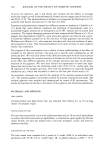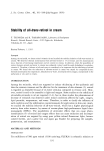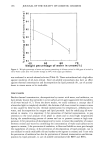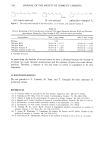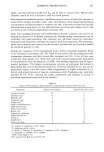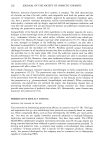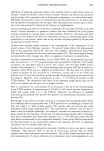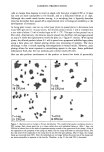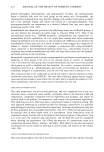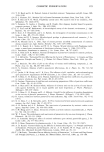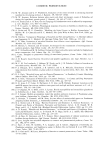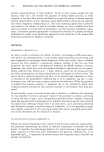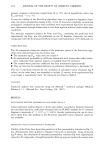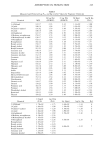HAIR MELANIN 189 visible light, IR, and global irradiation (Figure 5b) bring about a decrease of DHI- assigned bands (peaks 4 and 5). A gradual elimination of the absorption assigned to the sulfur moiety (peak 6) is evident upon exposure to UV-B and UV-A radiation (Figure 5a). SUMMARY This investigation provides qualitative and quantitative evidence regarding the different response to sunlight exposure of melanin from black and light-brown hair. The photochemical degradation by visible light of eumelanin, the predominant pigment of black and light-brown hair, is, under the conditions of these experiments, relatively small and can be shown quantitatively (gravimetry) and qualitatively (color measure- ments, IR-spectroscopy). On the other hand, a mixture of pheo- and eumelanins, the pigment of light-brown hair, appears to be affected by all segments of sunlight, particularly by UV-A and visible light. The irradiation brings about drastic degradation of the granules (gravimetry) and substantial changes in the melanin polymer (IR-spectroscopy, see below). IR investigation of the melanin of irradiated light-brown hair suggests extensive de- struction of the quinone system, which according to Crippa (3) is essential for the photoprotective effect of the melanin. In the case of eumelanin the dihydroxyindole moleties are prone to irradiation. The higher photostability of the eumelanin, particularly the limited degradation of the quinone structure, suggests that eumelanin has a better photoprotective effect on hair than pheomelanin. REFERENCES (1) j. P. Cesarini, "Melanin and Color of Hair" (in German), in Haar undHaarkrankheiten, C. E. Orfanos, Ed., pp. 137-166 (1979). (2) S. Ito and K. Fujita, Microanalysis ofeumelanin and pheomelanin in hair and melanomas by chemical degradation and liquid chromatography, Anal Bzochem., 144, 527-536 (1985). (3) R. Crippa, V. Horak, G. Prota, P. Svoronos, and L. Wolfram, "Chemistry of Melanins," in The Alkaloids, Vol. 36, A. Brossi, Ed. (Academic Press, 1989). (4) V. Boudier, Etude du comportement photochimique d'eumelanines et du complexe melanine-keratine du cheveu par spectroscopies raman et infrarouge, Thesis, UBP Clermont-Ferrand II (1989). (5) T. Sarna and R. C. Sealy, Photoinduced oxygen consumption in melanin systems. Action spectra and quantum yields for eumelanin and synthetic melanin, Photothem. Photobiol., 39 (1), 69-74 (1984). (6) T. Sarna, B. Pilas, E. J. Land, and T. G. Truscott, Interaction of radicals from water radiolysis with melanin, Biochim. Biophys. Acta, 883 (1), 162-168 (1986). (7) W. Korytowski and T. Sarna, Bleaching of melanin pigments, J. Biol. Chem., 265 (21), 12410- 12416 (1990). (8) N. S. Ranadive and I. A. Menon, Role of reactive oxygen species and free radicals from melanins in photoinduced cutaneous inflammations. Pathol. Immunopathol. Res., 5 (2), 118-139 (1986). (9) M. Tatsuda, M. Uemura, K. Torii, and M. Matsuoka, Studies on hair damage and demelanization by ultra violet light, J. Soc. Cosmet. Chem. Japan., 21, 43-49 (1987). (10) K. Jimbow, Y. Miyake, K. Homma, K. Yasuda, Y. Izumi, A. Tsutsumi, and S. Ito, Characterization of melanogenesis and morphogenesis of melanosomes by physicochemical properties of melanin and melanosomes in malignant melanoma, Cancer Res., 44 (3), 1128-1134 (1984).
190 JOURNAL OF THE SOCIETY OF COSMETIC CHEMISTS (11) (13) (14) (15) (16) (17) (18) M. R. Chedekal, P. R. Agin, and R. M. Sayre, Photochemistry of pheomelanin: Action spectrum for superoxide production, Photochem. Photobiol., 31 (6), 553-555 (1980). A. Menon, S. Persad, H. F. Haberman, and C. J. Kurian, A comparative study of the physical and chemical properties of melanins isolated from human black and red hair. J. Invest. Dermatol., 80 (3), 202-206 (1983). L. J. Wolfram and L. Albrecht, Chemical and photo-bleaching of brown and red hair, J. Soc. Cosmet. Chem., 82, 179 (1987). E. Hoting, M. Zimmermann, and S. Hilterhaus-Bong, Photochemical alterations in human hair. Part I: Artificial irradiation and investigations of hair proteins,J. Soc. Cosmet. Chem., in press (1995). M. Giesen, Isolation and determination of melanin in human hair (in German), Thesis, RWTH Aachen (1981). G. Reese and N. Maak, Die Best•indigkeit von Haarfarben unter dem EinfluB vom Sonne, Wasser, Salz, •rztl. Kosmetol., 12 (5), 373-379 (1982). K. Jimbow, O. Ishida, S. Ito, Y. Hori, C. J. Witkop, and R. A. King, Combined chemical and electron microscopic studies of pheomelanosomes in human red hair,J. Invest. Dermatol., 81, 506-511 (1983). G. Sokrates, Infrared Characteristic Group Frequences (1980).
Purchased for the exclusive use of nofirst nolast (unknown) From: SCC Media Library & Resource Center (library.scconline.org)



